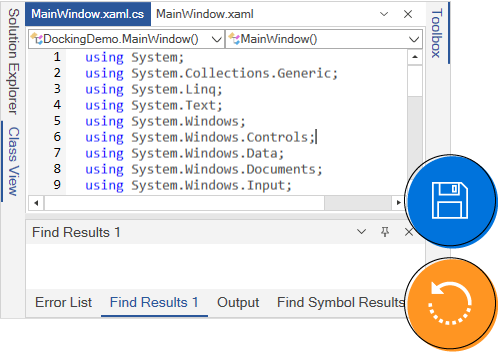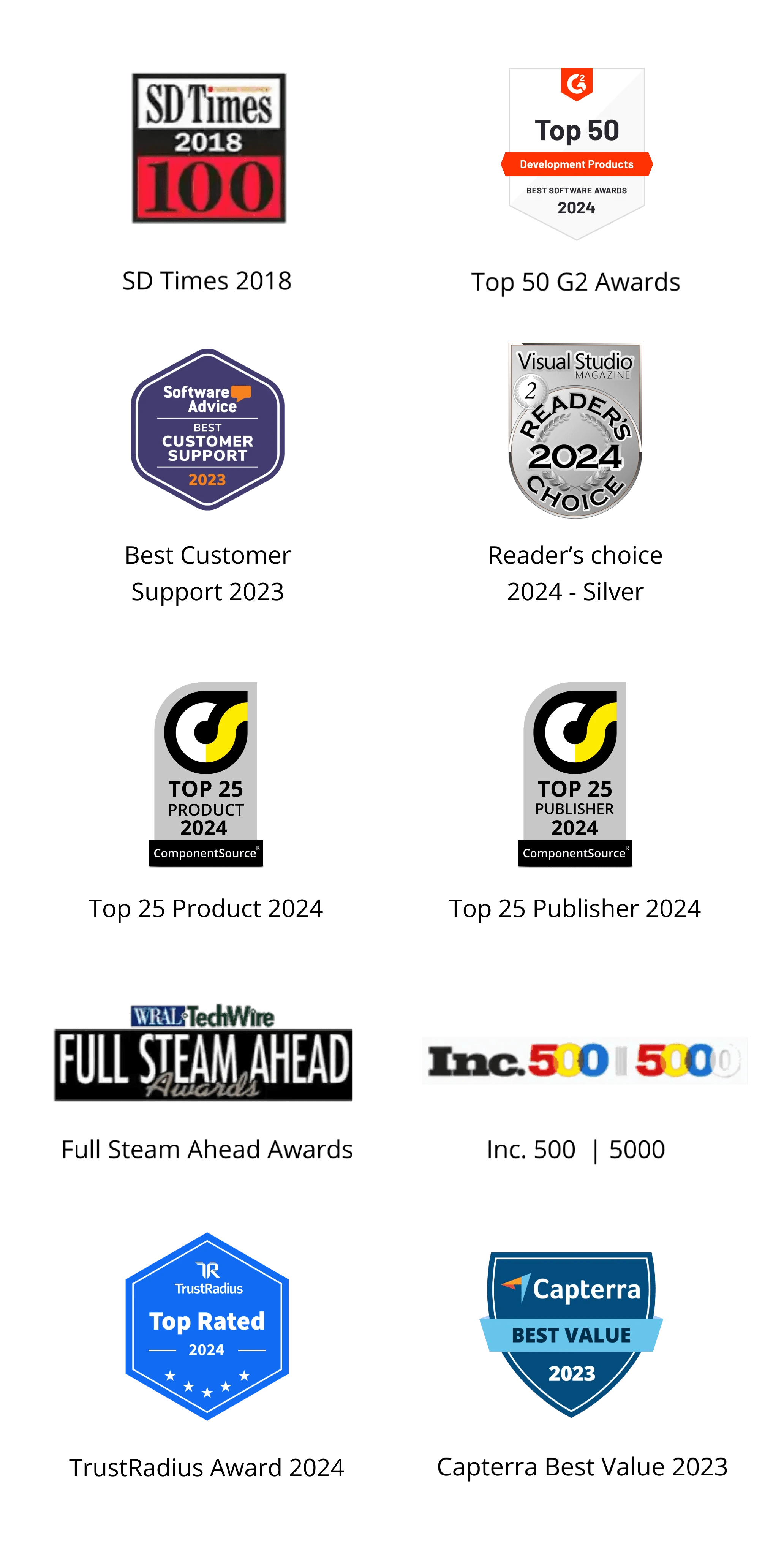Trusted by the world’s leading companies

Overview
The WPF Docking Manager (DockPanel) control provides an interface to create Visual Studio-like dockable windows in your applications. Dock panels support many interactions like docking, floating, tabbing, autohiding and grouping document tabs. Tab groups split the workspace and allow users to work with two or more open documents. Users can resize, move, and change the behavior of windows to create a layout that suits various development models.
WPF Dock Window Data Binding
Data Binding is the process of establishing a connection between the application UI and business logic. Data binding can be unidirectional or bidirectional. The WPF Docking Window has data-binding support to work with popular data sources like SQL Server, Oracle, data tables, and more..
Different kind of docking window
Dockable windows can be dragged by users, can float around the screen, and be pinned and unpinned by users. As in Visual Studio, Docking Manager offers different kinds of windows:
- Docking window
- Floating window
- Tabbed window
- Pinnable window
- Tabbed MDI Window

WPF AutoHide window
In the auto-hide state, tool windows display tabs along the tray area on the side of their dock host. The content of the corresponding tool window is displayed in an animated popup when a tab is clicked.
Close window
Users can close windows interactively through the close option in the UI. Close the active window alone or all tabbed windows.

Resizing windows
Users can interactively resize windows using a splitter between windows. Restrict resizing to minimum and maximum sizes for views.

Maximize view
Display the dock windows in maximized view to get more readability and restore interactively.

Transparent window dragging
The WPF Docking Manager control allows you to turn on or off the option to show a window’s contents while dragging it. When it is set off, a transparent dragging visual effect is used.

Snap and move multiple windows
Snap the float windows and move them together. Separate the snapped float windows by pressing the CTRL key and dragging the float window away from the group.

Restrict docking
End users can restrict windows to docking on specific sides of the target dock windows or edges of a form. They can customize the dock hints’ visibility to show dock hints only on a specific side.

Redock to previous location
Built-in redock support saves the previous state of dock or float windows and moves the windows to previous dock or float states after double-clicking on a caption.

Scroll tabs
Bring the overflow tabs into view through scroll options in the UI. Scroll to the next, previous, first, or last tabs.

Docking guides
Display docking guides to indicate the valid drop location for docking panels while dragging the float window. Also customize the appearance of the docking guides.

MDI/TDI functionalities
The MDI and TDI functionalities are applicable for the Document window in the DockingManager. So you can change Document window as both Multiple Document Interface and Tabbed Document Interface.
MDI
Allows multiple windows to reside under a single parent window in the Docking Manager.
TDI
Allows adding a child window as a document tab in the Docking Manager.
Context menu
The WPF Docking Manager control provides the support to improve the user experience with a built-in context menu. It helps users to float, close, pin, and move the dock window to a tabbed document and more.

Hide caption
Hide the visibility of a dock window caption to make the dock window appearance a flat panel.

Save and restore
Built-in serialization options support saving a dock layout upon closing and restoring it upon opening the application in different formats.

Complex docking layout
Users can create nested docking layouts with docked windows inside other docked windows, or directly dock them to the main form.

Linked docking
Easily drag the child windows from one docking manager to another by linking different docking managers together.

Style
Customize the style of each part of the WPF Docking Manager, such as its dock window header style and tabs styles. Use a rich set of built-in themes inspired by popular interfaces such as Visual Studio, Microsoft Office, and Expression Blend.

Localization
The WPF Docking Manager supports localization to translate the static text to any supported language.

Right to left
Right-to-left (RTL) direction setting is available for users working in right-to-left languages like Hebrew, Arabic, or Persian.

WPF Docking Window Code Example
Easily get started with the WPF Docking Window using a few simple lines of XAML and C# code example as demonstrated below. Also explore our WPF Docking Manager Example that shows you how to render and configure the docking window in WPF.
<syncfusion:DockingManager x:Name="dockingManager">
<ContentControl x:Name="SolutionExplorer"/>
<ContentControl x:Name="ToolBox"/>
<ContentControl x:Name="Properties"/>
<ContentControl x:Name="Output"/>
<ContentControl x:Name="StartPage"/>
</syncfusion:DockingManager>using System.Windows;
using Syncfusion.Windows.Tools.Controls;
namespace DockingManager_SampleWpfApp1
{
public partial class MainWindow : Window
{
public MainWindow()
{
InitializeComponent();
DockingManager dockingManager = new DockingManager();
ContentControl SolutionExplorer = new ContentControl();
ContentControl ToolBox = new ContentControl();
ContentControl Properties = new ContentControl();
ContentControl Output = new ContentControl();
ContentControl StartPage = new ContentControl();
//Add content controls as child of DockingManager
dockingManager.Children.Add(SolutionExplorer);
dockingManager.Children.Add(ToolBox);
dockingManager.Children.Add(Properties);
dockingManager.Children.Add(Output);
dockingManager.Children.Add(StartPage);
this.Content = dockingManager;
}
}
}Not sure how to create your first WPF Docking? Our documentation can help.
I’d love to read it now145+ WPF CONTROLS
Frequently Asked Questions
Why should you choose Syncfusion WPF Docking?
Syncfusion WPF Docking provides the following:
- Rich, Visual Studio clone-like UI.
- Multiple docking states.
- Complete customization from container to pin.
Excellent drag and dock support.
Inbuilt, full-screen float window.
State-of-the-art state persistence support.
- Complete localization support to add new languages.
- Has a simple configuration and APIs.
- Is touch-friendly and responsive.
Learn quickly and get started with WPF Docking using its extensive demos and documentation.
Can I download and utilize the Syncfusion WPF Docking for free?
No, this is a commercial product and requires a paid license. However, a free community license is also available for companies and individuals whose organizations have less than $1 million USD in annual gross revenue, 5 or fewer developers, and 10 or fewer total employees.
How do I get started with Syncfusion WPF Docking?
A good place to start would be our comprehensive getting started documentation.
Our Customers Love Us


 Documentation
Documentation
Awards
Greatness—it’s one thing to say you have it, but it means more when others recognize it. Syncfusion® is proud to hold the following industry awards.












